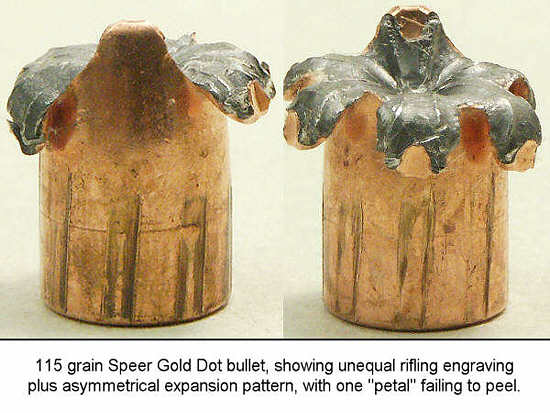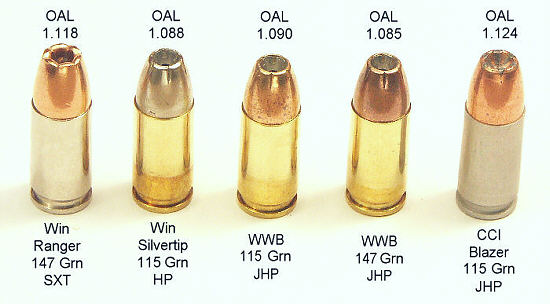If no menu
or buttons show
ensure you have
scripting enabled
Please give time
for menu to load


|
|
The Bullet Tumbling
Factor
|
|
Much has been made
of the fact that on occasions there is evidence
of some bullet tumble .... sometimes evident from
a target when the ''soot smudge'' around the hole
is other than uniform.
The photograph below was one taken at the end of
test #3 when testing expansion in wetpack. Initially
I was puzzled most with regard to the apparent uneveness
of the rifling engraving around the bullet driving
area. It certainly seemed that this bullet impacted
the wetpack slightly off axis, thus one ''petal''
failed to peel back - the rifling idiosyncracy however
I was unsure about initially.
The answer came quickly from Rohrbaugh when I brought
the matter up ... that is written up below this
picture.

|
|
Explanation
for the above.
After a discussion with
Karl Rohrbaugh it is now quite clear why and how this
can happen.
The design of the barrel is such that there is a significant
freebore* of 0.250" - the reason for which
being pressure control. As we all know I think, the
9mm Parabellum is a high pressure round, even at standard
pressures. This small delay before bullet engagement
with rifling permits the immediate pressure peak to
dissipate to a safer level - sparing the barrel/slide
mechanism some extreme trauma. This is both desirable
and necessary with the design of such a small gun using
this round.
Further to this - it can probably be imagined therefore
that not every bullet of every type will engage the
rifling with absolute symmetry, per the example above.
This then also explains why there are occasions also
where a perceptible degree of bullet tumble is seen
after exit from the gun.
I have stated more than once - this gives me no cause
for concern, seeing as the likelhood of long range engagements
is remote. It being much more likely that ''things''
would be happening within ten feet or so. At this distance
I doubt if an assailant is going to make much complaint
if he is hit by a 100% stable bullet - or one which
started to tumble a little!
*''Freebore'' - the distance from chamber
end to beginning of rifling grooves and lands .. a distance
the bullet must ''jump'' from cartridge to onset of
engagement and engraving. Necessary on all firearms
but usually a smaller figure. With rifles, often only
perhaps 25 thousanths of an inch. |
A
word on tumbling and ammo in general ........
For the most part, Speer Gold Dot is the ammo' par excellence
for this gun, also included is CCI Blazer with aluminum
cases - it uses the Speer bullet also. Functioning is
best with these choices and also in my experience tumbling
is very infrequent.
Some FMJ ammo used for practice does seem slightly more
inclined to tumble at times .... as do some other JHP
varieties. Again, this is infrequent enough for me to
not be overly concerned.
I will point out though that there is considerable variation
in ammunition I have sampled from different sources.
For a start I find all too many bullets mic' up at nearer
0.354" than the desirable 0.355-0.356", the
barrel major diameter being 0.355". Even this will
reduce engraving, the lands being a minor diameter I
believe, of 0.352"

Look also at the rounds shown in the image above - you
will notice quite a variation in OAL. In fact, the CCI
Blazer is the longest ... that dimension being almost
identical also with Speer Gold Dots (not in this pic'
I am afraid). Bullet ogives are not majorly that variable
it seems and probably it is seating depth mainly governing
these variations.
In my book, the longer OAL is less likely to provoke
much tumbling - compare 1.124" of the Blazer (or
Gold Dot) with the Winchester White Box 147's, which
are 1.085" - the difference is all but 40 thou
- that is in effect increasing the freebore which is
already large.
This is enough I maintain to probably increase the tumbling
possibility, as the bullet jumps the effectively longer
gap before engaging the rifling, the case headspacing
of course is a constant. Whether a bullet exits a case
totally axially every time I very much doubt, and the
longer it has to destabilize before entering rifling,
the more likely is an asymmetrical engagement.
|
|
Back to Top
|


